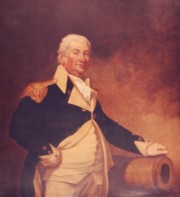The current Montpelier, built 1929-1931, is a replica of the original. After many years attempting to raise funds for construction, publisher and philanthropist Cyrus H. K. Curtis donated $250,000 to more than match the $50,000 raised by the Knox Memorial Association.The original was designed in part by Knox himself, and to some degree by noted architect Charles Bulfinch.
From Penobscot to the Kennebec, from Moosehead to the sea,
Was spread the forest barony of Knox, bluff Knox;
And the great house on the Georges it open was and free,
And around it, all uncounted, roved its bonny herds and flocks,
Oh, free were feast and frolic, and hurrah for the rowse,
And hurrah for great “Montpelier” when
Knox kept open house!
—Holman Day, from “When General Knox Kept Open House,” in Kin O’ Kataadn, 1901, p. 174.
Henry Knox (1750-1806) was born in Boston to William Knox and Mary Campbell. He married Lucy Flucker (1756–1824) in 1774. They had 12 children, but only three lived to adulthood.
Before his military career, Knox owned a bookstore in Boston. He joined the local militia, and at the outbreak of the American Revolution, befriended General George Washington and served as his civilian military advisor. In November 1775, Washington appointed Knox chief of artillery for the Continental Army.
Knox participated in many key events in the Revolution. He headed the mission to bring the arsenal at Fort Ticonderoga to Cambridge, Massachusetts, which Washington used in the siege of Dorchester Heights. He accompanied Washington in the campaigns in New York and New Jersey (1776-1777); trained troops and officers in the use of artillery at Pluckemin, New Jersey (1778-1779); and was a member of John André’s court martial in 1780. Knox was promoted major general in 1782, and established a headquarters at West Point.
The Continental Congress appointed Knox Secretary of War on March 8, 1785, and he retained the post until 1794. Knox focused much of his attention on managing Indian affairs in the Ohio territory. He was in charge of supplying the frontier forces, and involved in the decision-making that lead to Brigadier General Josiah Harmar’s defeat at Fort Washington in 1790, St. Clair’s defeat (Battle of the Wabash) in 1791, and the ongoing negotiations with the Western Indian Confederacy (the Miami, Shawnee, and Delaware Indians) between 1792 and 1794.
Knox left the War Department in 1794 and retired to a mansion called Montpelier, in Thomaston, which Lucy Knox had inherited. Fort Knox in Kentucky and Fort Knox in Maine are both named after the general.
Henry speculated heavily in land and various local industries, such as lumber, shipbuilding, brick making, and quarrying. His investments all failed and debtors forced him to sell much of his land. Knox died in 1806 from an infection after swallowing a chicken bone.
Additional resources
Source: (right column only) Verbatim, but slightly reformatted, from “Finding aid for Henry and Lucy Knox Collection, 1777-1807,” Manuscripts Division, William L. Clements Library, University of Michigan. Created by Philip Heslip, June 2011. http://quod.lib.umich.edu/c/clementsmss/umich-wcl-M-123kno?view=text (accessed December 30, 2011)
“Henry Knox.” https://www.mountvernon.org/library/digitalhistory/digital-encyclopedia/article/henry-knox/


![Knox Mansion Montpelier, reconstruction (2001) Knox Mansion Montpelier [reconstruction] (2001)](https://maineanencyclopedia.com/wp-content/uploads/knoxman2-180x119.jpg)
